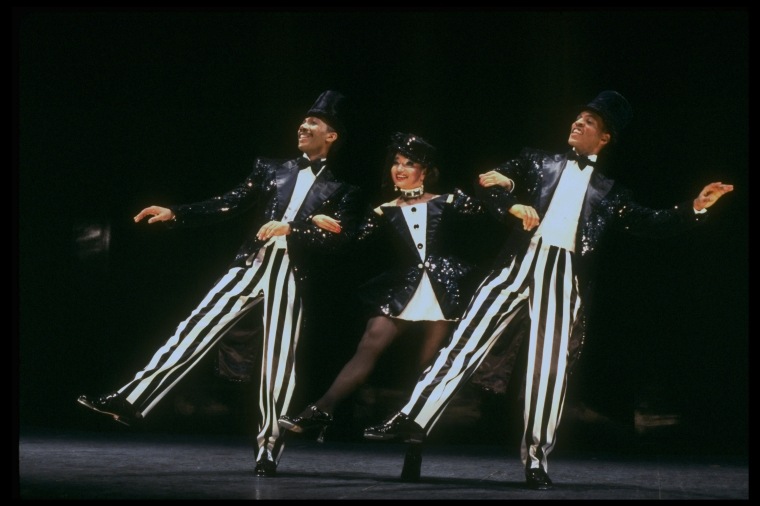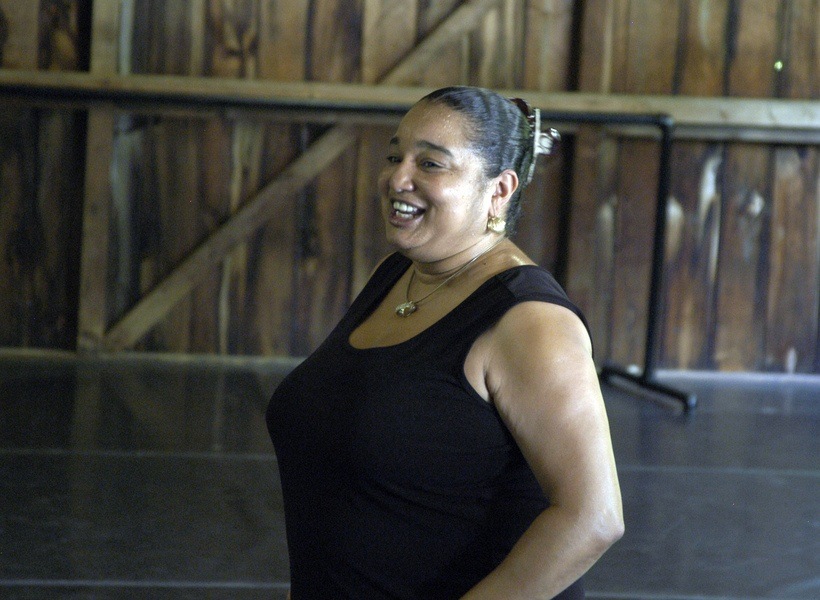Lady Di
It doesn’t take long, upon encountering the tap dancing of Dianne Walker, to understand why she is called “Lady Di.” Witness her (below) at her Pillow debut in 1996, buoyant on the jazz waltz “Emily,” her trademark tune. Here is a woman of regal ease, comfortable in herself. She’s contained, controlled. Her taps are softened, their crystalline tone nearly pearlescent. Her phrasing is tasty, its refinement roughened at the edges by soulfulness. It tells a story, augmented by her conversationally active hands, head, and shoulder-padded shoulders. Notice how she takes her time at the end, coasting around the musicians before finally deciding to land: down to just a quiet cascade of heel drops, shimmering deliciously towards silence. Then—the sign of artistic authority—surging up once more as she cues the final chord.
Notice, too, though, how—just thirty seconds into the waltz—she samples the airborne heel clicks of a waltz clog, two in a row, and how the second time she hops up, she supports her ample breasts with her hands. The gag gets a laugh, as intended. Here is a lady with a sense of humor.
Here, moreover, is an adult artist, 45 at the time, who has lived a few decades and has something to say. Here is a welcoming conversationalist. It doesn’t take long, in other words, to understand Walker’s other nickname: Aunt Dianne.
A Life in Tap
She was born in Boston, in 1951. As an infant, she contracted polio and was sent to dance class for the exercise. Eventually, she ended up in the studio of Mildred Kennedy, a tap dancer who had performed as “The Brown Bomber” on the New England vaudeville circuit before opening a dancing school of exacting standards. Walker (then Dianne Taylor) became the star student, such that when she was ten and her family moved to Edwards Air Force Base in California, Kennedy asked if the girl might stay with her. Out West, Walker kept dancing, but when she was fourteen, her family moved again, to Okinawa, where there was no tap.
Though she was a drummer and a majorette in high school, tap stayed out of her life as she moved back to Boston, got married, gave birth to two children, and earned a master’s degree in psychology. Then, when she was twenty-six, she came upon Willie Spencer, a hiply eccentric vaudevillian who reminded her of the kind of men who used to come by Kennedy’s studio. Spencer sent Walker to the classes of another veteran tap dancer, Leon Collins.
Collins was from Chicago and had been a soloist with major jazz bands in the forties, a leader in the generation of hoofers adapting to the rhythms of bebop. But when the work for tap dancers dried up in the fifties and sixties, he retired to Boston and reupholstered cars. His new friends did not know he had ever been a dancer. By the time that Walker met him, though, in 1977, he had started teaching tap, channeling his step-making invention into a brilliant series of educational routines. “It makes me disgusted,” he would say, “when I make up a step and there’s no one to give it to.” Soon, Walker was a favorite pupil again.
And, to afford her lessons, she became a teacher, too, taking over Collins’s classes for children. With her fellow students Pam Raff and C.B. Hetherington, she began dancing professionally with Collins, who insisted upon bringing his “dumplings” whenever he was invited to perform. As the only black woman in the group, Walker stood out. But she also attracted attention for other qualities, such as the “easy warmth” noticed by the New York Times critic Jennifer Dunning, who singled Walker out in a review of a show (Jane Goldberg’s Sole Sisters) in which Walker had appeared only in the post-show jam session.
That was in 1985, the year that Collins died of cancer. On his deathbed, he raised himself up into Walker’s face and told her, “You dance for me.” And that is what she proceeded to do.
A pair of Argentine producers was organizing a 1920s and ‘30s revue in Paris called Black and Blue. At 32, Walker went on the first audition of her life, for the chorus line. “A leggy chorus girl went before me,” she remembered, “and my daughter looked at her and looked at me and asked, ‘Are you auditioning for the same part?” The audition seemed to Walker like a disaster. But the choreographer, Henry LeTang, took a liking to her, telling her he hadn’t seen anyone in years who tapped as she did. “I got the part,” Walker recalled, “not the leggy chorus girl.”
Rehearsals were tough. “I lost thirty pounds,” Walker said. “I was crying in the shower at night. I told a friend that when I died, she should tell my kids that I tried.” Walker earned a specialty spot in a trio number, and when the show transferred to Broadway a few years later, she became assistant choreographer and the only woman to dance on the Hoofers’ Line with such veterans as Jimmy Slyde.

This was all good for Walker—Black and Blue put her kids through college—but she also had ideas about what would be good for tap. Back in 1985, she had substituted for Collins in a show in Rome. The producers wanted children, so Walker brought three of her male students (including the future Pillow regular Derick Grant) and two girls from the Los Angeles studio of Mildred Kennedy’s children (including the future Pillow regular Dormeshia Sumbry-Edwards). Also attending was the current teenaged star of The Tap Dance Kid on Broadway: Savion Glover.
Walker had been thinking that tap needed a kid – to inspire other kids, to make tap youthful and hip again. Glover was the one. Joining Black and Blue in Paris, he couldn’t get enough of the veteran hoofers and everything tap. “My kids would do anything to stop me from talking,” Walker remembered, “but I could talk tap with Savion forever. He became a great little repository.” Everyone started calling him the Sponge. He started addressing Walker as Aunt Dianne.
When Black and Blue transferred to Broadway, Walker wanted to give other kids the experience that Glover had, so she convinced the producers to hire more children: the girls from the Kennedy school, plus understudies for Savion. This was the beginning of a generation growing up with Glover, pulled to higher standards by his rocketing example: the first of several generations that sought and received guidance from Aunt Dianne.
Walker herself never became very famous beyond the field of tap. Her appearance in Gregory Hines’s 1989 film Tap was a blip. She did not have a company of her own and was not a member of one. She did not choreograph. She lived with her family in Boston, not New York. But Walker was nevertheless a pillar of the tap community: a teacher, a role model, and, always, a mighty fine dancer.
Pied Piper at the Pillow
Walker played all those roles at the Pillow. Watch footage of her 1996 Pillow debut (above) after watching footage of her teacher, Leon Collins, (also above) and you catch signs of influence—an understated style; a preference for tidy, epigrammatic phrases; even certain short sequences—but equally how she took what he gave her and made it her own, expressive of her personality. That 1996 debut came during the opening-night gala of the first Pillow season organized by Sali Ann Kriegsman. A longtime champion of tap, Kriegsman considered Walker to be the “Pied Piper of tap,” and arranged for her and Jimmy Slyde to head a Jazz Tap Residency Project, performing and teaching all over the Berkshires. Even after the funding ran out, Walker kept returning, giving workshops, giving of herself.
Walker returned as well as a guest artist with the company Jazz Tap Ensemble in 1998. From night to night, she might ask the band for the same few songs or maybe substitute a new one. And since multiple performances were filmed, it’s possible to watch successive attempts, inspired one night, perhaps slightly less so the next:
Walker’s conversational fluency as a tap dancer is intimately connected with her conversational fluency as a person. It’s part of what makes her a great educator. (And her garrulousness is another aspect of herself she can joke about: before one of the performances above, she noted that people who knew her might be alarmed to see her with a microphone in her hand; she promised to keep her remarks short.) Listen to her explain (below), in a post-performance panel, how inspiration doesn’t always strike, and about how she then has to reach into her library of “pocket steps,” relying on her knowledge and experience.
And about one time when something special did happen:
In 2005, Savion Glover had his first show at the Pillow (after a one-off appearance at the 2002 Gala). Walker, along with Jimmy Slyde, was an honored guest artist. It was a family affair, full of love and mutual respect. And it was especially touching when Glover, habitually intense and high-speed, slowed down into Walker’s zone so that he might dance with her.


In a PillowTalk that year, Walker was asked a question she had been asked many times before, about the place of women in tap. The answer she gave was the same one (another kind of “pocket step”) that she had given in 1996:
Tap is a male form. . . but it’s now dominated by women.”
Frank, tell-it-like-it-is, unafraid to upset multiple factions—the line was as characteristic of Walker as the sound of her taps. But it also expressed a personal truth. Again and again over the years, she said that it had been men like Leon Collins and Jimmy Slyde who had inspired her, their sense of style and musicality. They had told her, (as she recalled) “Hit it, but don’t hit it like us, girlie.” How she had taken their advice and example to heart was evident every time she danced. No one, enjoying the dancing of Lady Di, could think of the heights of tap artistry as a place only for men.
PUBLISHED April 2017